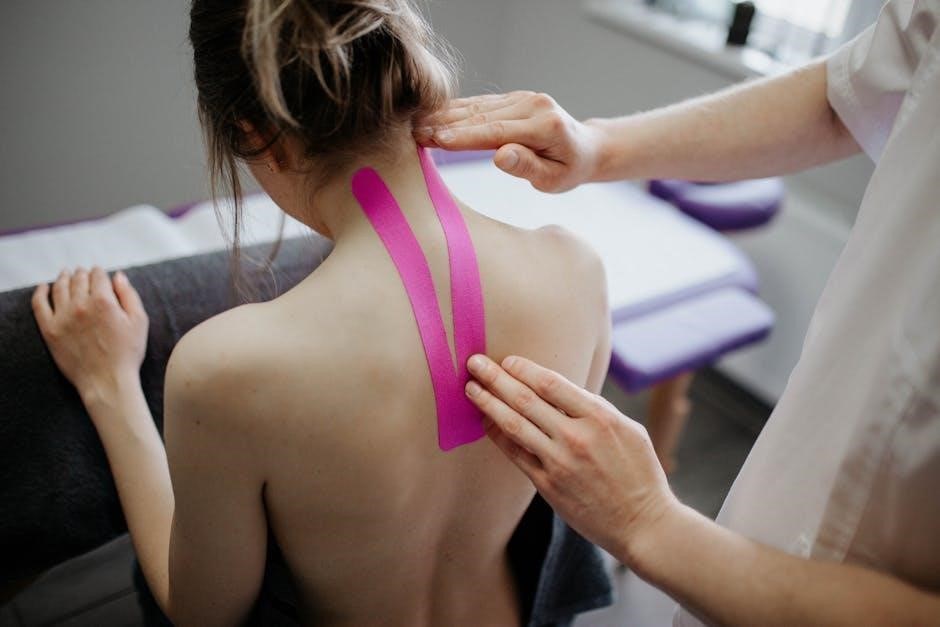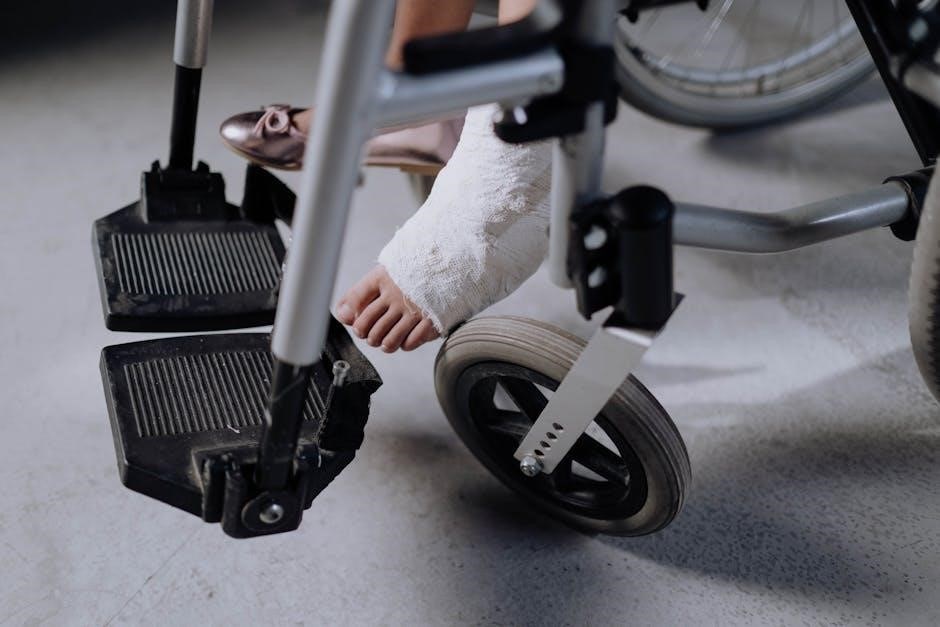Hip fracture rehabilitation is a critical process to restore mobility and strength after injury. A structured protocol ensures proper recovery, improves functional outcomes, and enhances quality of life.
1.1 Overview of Hip Fractures and Their Impact
Hip fractures are breaks in the upper leg bone, often caused by falls or osteoporosis. They are most common in the elderly, leading to pain, limited mobility, and increased dependency. Prompt treatment is essential to prevent complications and restore function, as untreated fractures can severely impact quality of life and long-term independence.
1.2 Importance of a Structured Rehabilitation Protocol
A structured rehabilitation protocol is essential for promoting optimal recovery, reducing complications, and improving functional outcomes. It ensures a tailored approach, addressing individual needs and progression. A well-defined plan minimizes risks, enhances mobility, and supports patients in regaining independence, making it a cornerstone of effective hip fracture management and recovery.

Types of Hip Fractures and Surgical Interventions
Hip fractures vary in type, including intracapsular and extracapsular fractures. Surgical interventions like hemiarthroplasty and intramedullary nailing are common, aiming to restore function and stability post-injury.
2.1 Classification of Hip Fractures
Hip fractures are classified into intracapsular and extracapsular types. Intracapsular fractures occur within the hip joint capsule, while extracapsular fractures, like intertrochanteric and subtrochanteric, occur outside. Accurate classification guides treatment planning and rehabilitation strategies, ensuring optimal recovery outcomes for patients.
2.2 Common Surgical Procedures for Hip Fractures
Common surgical procedures for hip fractures include hemiarthroplasty, intramedullary nailing, and open reduction internal fixation (ORIF). Hemiarthroplasty replaces the femoral head with a prosthetic, while intramedullary nails stabilize fractures internally. ORIF involves aligning and securing bone fragments with screws or plates. Each procedure is chosen based on fracture type, patient health, and lifestyle to promote effective recovery and mobility restoration.
Immediate Post-Surgical Care and Diagnosis
Post-surgery, pain management and monitoring are prioritized. X-rays confirm fracture repair success, guiding weight-bearing status and rehabilitation planning. Orthopedic teams assess healing progress and address complications promptly.
3.1 Diagnostic Process for Hip Fractures
The diagnostic process begins with X-rays to confirm the fracture and determine its type. Orthopedic surgeons analyze these images to assess fracture severity, displacement, and alignment. This information guides treatment decisions, including whether surgery is necessary and the most appropriate surgical approach. Accurate diagnosis ensures tailored interventions, improving recovery outcomes and minimizing complications. Early diagnosis is crucial for effective rehabilitation planning.
3.2 Immediate Post-Surgery Care and Pain Management
Immediate post-surgery care focuses on pain management and recovery. Patients are asked to rate pain on a 0-10 scale to guide medication. Pain relief strategies include prescribed medications and non-medication approaches. Nurses monitor pain levels and adjust treatments accordingly. Early mobilization is encouraged to prevent complications, and physical therapy begins soon after surgery to restore mobility and strength. Patient education on pain control and recovery is prioritized.

Rehabilitation Protocol Phases
Hip fracture rehabilitation is divided into three phases: acute recovery (0-2 weeks), subacute recovery (2-6 weeks), and advanced recovery (6-12 weeks), each focusing on progressive healing and mobility restoration.
4.1 Phase 1: Acute Recovery (0-2 Weeks)
Phase 1 focuses on pain management, wound healing, and initial mobilization. Patients often require assistive devices for transfers and limited weight-bearing activities. Gentle exercises, like knee bends and ankle pumps, are introduced to prevent stiffness and promote circulation. Close monitoring by healthcare providers ensures a safe transition to more active recovery in subsequent phases.
4.2 Phase 2: Subacute Recovery (2-6 Weeks)
Phase 2 focuses on progressing mobility and strengthening. Patients begin weight-bearing exercises, transfer training, and hip-strengthening activities. Gentle exercises like hip abductions and knee extensions are introduced. Mobility aids are gradually reduced as strength improves. The goal is to enhance functional independence and prepare for advanced recovery phases by improving balance, flexibility, and overall lower extremity function.
4.3 Phase 3: Advanced Recovery (6-12 Weeks)
Phase 3 emphasizes restoring full strength and mobility. Patients engage in dynamic exercises, resistance training, and high-level balance activities. Weight-bearing progressions and advanced gait training are prioritized; The focus shifts to returning to daily activities and achieving pre-injury functional levels, ensuring long-term independence and minimizing the risk of future complications through sustained rehabilitation efforts and proper care.

Weight-Bearing and Mobility Guidelines
Weight-bearing progression is tailored to fracture stability, ensuring safe mobilization. Early transfer techniques and gait training are emphasized to restore mobility and independence, minimizing recovery delays.
5.1 Weight-Bearing Restrictions and Progression
Weight-bearing restrictions are crucial post-surgery, often starting with non-weight-bearing status. Gradual progression to partial and full weight-bearing is guided by fracture healing and pain tolerance. Patients may use assistive devices like walkers or crutches to safely transition, ensuring minimal stress on the hip during recovery. This approach minimizes complications and supports optimal healing outcomes.
5.2 Early Mobilization and Transfer Techniques
Early mobilization is essential for preventing complications and promoting recovery. Techniques include transitioning from bed to chair, using walking frames, and practicing safe transfers. Patients are encouraged to perform exercises like supine hip abduction and bent-knee fallout to maintain range of motion. Caregivers assist with proper positioning and movement to ensure safety and progress during the initial recovery phase.

Range of Motion and Strengthening Exercises
Range of motion exercises, like supine hip abduction and bent-knee fallout, improve joint mobility. Strengthening exercises, such as standing on one leg, enhance muscle stability and support recovery.
6.1 Hip and Lower Extremity Strengthening Exercises
Hip and lower extremity strengthening exercises are essential for recovery. Exercises like supine hip abduction and standing on one leg target hip muscles, improving stability. Bent-knee fallout and ankle pumps enhance circulation and strength. These exercises focus on muscles around the hip joint to support recovery, reduce pain, and prevent future injuries, promoting long-term mobility and independence.
6.2 Range of Motion Exercises for Recovery
Range of motion exercises are vital for restoring hip mobility. Gentle movements, such as hip flexion and knee extensions, prevent stiffness. Progressing slowly ensures safe recovery. These exercises promote joint flexibility, reduce discomfort, and improve functional outcomes, aiding patients in regaining independence and returning to daily activities effectively.

Pain Management and Medication Guidelines
Pain management is crucial for recovery. Patients rate pain on a 0-10 scale. Medications are prescribed based on severity, with monitoring for effectiveness and side effects.
7.1 Pain Assessment and Monitoring
Pain assessment involves evaluating the intensity using a 0-10 scale. Regular monitoring ensures effective pain control, allowing patients to participate in rehabilitation activities comfortably. Accurate documentation and adjustments to treatment plans are essential for optimal recovery and patient well-being.
7.2 Medication and Non-Medication Pain Relief Strategies
Pain management incorporates prescribed medications, such as analgesics, and non-medication approaches like ice or heat therapy. These strategies aim to reduce discomfort, enabling patients to engage in rehabilitation exercises effectively. Regular monitoring ensures personalized adjustments, optimizing comfort and promoting a smoother recovery process.

Role of Caregivers and Support Systems
Caregivers play a vital role in assisting with exercises, mobility, and daily tasks, while providing emotional support to enhance recovery and overall well-being for hip fracture patients.
8.1 Involvement of Family and Caregivers in Rehabilitation
Families and caregivers play a crucial role in supporting hip fracture recovery by assisting with exercises, providing emotional support, and ensuring adherence to rehabilitation protocols. Their involvement helps patients maintain motivation and safety during recovery. Caregivers should receive guidance from healthcare professionals to effectively aid in daily activities and mobility, fostering a collaborative environment for successful rehabilitation outcomes.
8.2 Community Resources for Hip Fracture Recovery
Community resources, such as support groups, physical therapy centers, and home care services, are essential for hip fracture recovery. Websites like www.orthoconnect.org and hotlines provide guidance and connect patients with local assistance. These resources help patients access necessary care, rehabilitation tools, and emotional support, ensuring a smoother transition to independence and improving overall recovery outcomes.

Physical Therapy and Exercise Programs
Physical therapy is crucial for restoring mobility and strength after a hip fracture. Tailored exercise programs focus on improving flexibility, balance, and hip stability, aiding patients in regaining independence.
9.1 Customized Exercise Plans for Hip Rehabilitation
Customized exercise plans are tailored to address individual recovery needs, focusing on strengthening hip muscles, improving range of motion, and enhancing mobility. These plans adapt as patients progress through recovery phases.
Exercises are designed to promote functional independence, with activities ranging from gentle movements to weight-bearing tasks. Progression is guided by pain tolerance and functional goals, ensuring safe and effective rehabilitation outcomes.
9.2 Role of Physical Therapists in Recovery
Physical therapists play a crucial role in guiding patients through tailored exercises, improving mobility, and restoring strength. They assess individual progress, adjust rehabilitation plans, and provide expert guidance on safe movement techniques. Their expertise ensures patients achieve optimal functional recovery and independence, addressing specific challenges and promoting long-term mobility.

Complications and Rehabilitation Challenges
Hip fractures may lead to complications like infections or blood clots. Rehabilitation challenges include limited mobility, pain, and pre-existing conditions. Addressing these issues is crucial for recovery.
10.1 Common Complications in Hip Fracture Recovery
Hip fracture recovery can lead to complications such as infections, blood clots, or prolonged immobility. Infections may arise from surgical sites, while blood clots can develop due to limited movement. Additionally, muscle atrophy and joint stiffness may occur if mobility is not restored promptly. Addressing these issues early is vital to prevent long-term functional impairment and ensure a successful recovery.
10.2 Addressing Rehabilitation Challenges
Rehabilitation challenges, such as pain, limited mobility, or adherence to protocols, require tailored strategies. Pain management and caregiver support are crucial. Regular monitoring of progress ensures early detection of complications. Emotional and physical challenges must be addressed to promote adherence to exercise and mobility plans, fostering a successful recovery and minimizing setbacks.

Long-Term Recovery and Quality of Life
Long-term recovery focuses on regaining independence and improving functional outcomes. Returning to daily activities and enhancing overall well-being are key goals to restore quality of life post-fracture.
11.1 Improving Functional Outcomes
Improving functional outcomes in hip fracture recovery focuses on regaining independence and mobility. Personalized exercise plans, caregiver support, and consistent rehabilitation protocols help restore daily activity performance. Strengthening muscles, improving balance, and addressing mobility challenges are key strategies to reduce disability and enhance overall well-being, ensuring patients can return to their normal lives effectively.
11.2 Returning to Daily Activities and Independence
Returning to daily activities and independence involves gradual progression in mobility and strength. Structured exercises, caregiver assistance, and mobility aids like walkers or canes support this process. Patients learn to perform tasks safely, reducing the risk of falls. The goal is to regain autonomy in self-care, household tasks, and social engagement, enhancing overall independence and quality of life.
Hip fracture rehabilitation requires adherence to structured protocols for optimal recovery. Advances in medical techniques and personalized care promise improved outcomes, enhancing patient independence and long-term quality of life.
12.1 Summary of Key Rehabilitation Strategies
Effective hip fracture rehabilitation involves early mobilization, weight-bearing exercises, and physical therapy. Key strategies include pain management, strengthening exercises, and caregiver support. A structured approach ensures gradual progression, promoting independence and functional recovery while minimizing complications.
12.2 Advances in Hip Fracture Rehabilitation
Recent advancements in hip fracture rehabilitation include personalized exercise plans, advanced weight-bearing progressions, and telehealth support. Innovations like orthobiologic therapies and wearable devices enhance recovery. These strategies aim to improve outcomes, reduce complications, and accelerate return to independence, ensuring more effective and patient-centered care.



